Tech Won't Replace Architects: NIA Secretary General Debunks Automation Fears

The rise of artificial intelligence (AI) and advanced design software has sparked concerns across various industries about potential job displacement. Architecture is no exception. However, Mrs. Adaku Oguamanam, Secretary General of the Nigerian Institute of Architecture (NIA), Lagos State Chapter, firmly believes that technology will augment, not replace, the role of architects. In an exclusive interview, she addresses these anxieties, explaining why the human element – creativity, critical thinking, and client understanding – remains indispensable.
“The narrative that technology will render architects obsolete is simply unfounded,” Oguamanam states. “While tools like BIM (Building Information Modeling) and AI-powered design platforms are revolutionizing the way we work, they are ultimately tools. A carpenter doesn't become irrelevant because of a power saw; they learn to use it to enhance their craft. Similarly, architects must embrace technology to become more efficient and innovative, but the core skills of design, problem-solving, and communication will always be paramount.”
The Human Touch in Architecture
Oguamanam emphasizes that architecture is far more than just drawing lines and creating blueprints. It's about understanding human needs, cultural context, and environmental sustainability. “Architecture is about creating spaces that enhance lives, that inspire, and that reflect the values of the people who will inhabit them. That requires a level of empathy, creativity, and critical judgment that AI simply cannot replicate.”
She highlights the importance of architect’s ability to interpret client needs, navigate complex regulations, and collaborate effectively with engineers, contractors, and other stakeholders. These are skills that require nuanced communication, negotiation, and leadership – qualities that are fundamentally human.
Embracing Technology for Enhanced Design
Rather than fearing technology, Oguamanam urges architects to actively engage with it. “BIM, for instance, allows for greater collaboration, improved accuracy, and more efficient project management. AI can assist with tasks like generating design options and optimizing building performance. But ultimately, it’s the architect who makes the critical decisions, who integrates these tools into a cohesive design vision.”
She also stresses the need for architectural education to evolve, equipping students with the skills to navigate this rapidly changing landscape. “We need to train architects who are not only proficient in design but also technologically savvy, capable of leveraging these tools to create better, more sustainable, and more human-centered spaces.”
Looking Ahead: A Collaborative Future
Oguamanam envisions a future where architects and technology work in synergy, each complementing the other’s strengths. “The future of architecture is not about humans versus machines, but about humans with machines. It’s about harnessing the power of technology to unlock new possibilities in design and to create a built environment that is truly responsive to the needs of society.”
Her message is clear: the role of the architect is not under threat, but rather evolving. By embracing technology and continuing to hone their core skills, architects will remain vital contributors to the built environment for generations to come. The focus should be on adaptation, continuous learning, and leveraging technology to enhance, not replace, the essential human elements of architectural practice.






